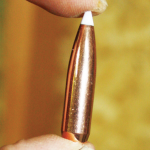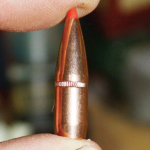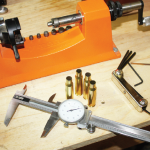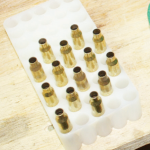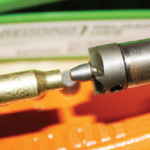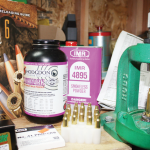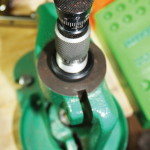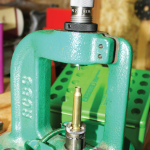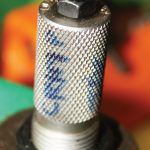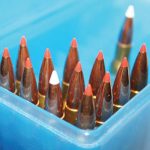by Dave Workman
Senior Editor
- Sometimes, you’ve got to bite the bullet, or at least a fragment, on the campaign trail.
- Hornady’s SST is a boattail with a crimping cannelure.
- Brass should be measured and trimmed, and for that you need a reliable caliper like this one from RCBS and a good case trimmer like this Lyman.
- Save those plastic cartridge blocks from ammo boxes because they make great impromptu loading blocks.
- Close-up of case trimming operation. Case mouth fits over guide and carbide cutters trim the surface uniformly.
- Successful reloading requires a good loading manual and quality components, including bullets, primers and powder, a reliable press—and patience.
- Redding produces a micrometer competition seating die that is superb. Author Workman got a set for his son Josh’s .223-caliber ammunition after the younger Workman built his own sport-utility rifle.
- Empty cases must be re-sized, and here is a .223-caliber case heading into the Redding sizing/decapping die. Notice the decap pin projecting down from the die.
- Workman suggests having two seating dies, one for seating bullets with a taper crimp and one for bullets with a crimping cannelure. He labels the dies like this one for .308 Winchester, so he can load rounds without having to adjust his seating die.
- A recent batch of .30-06 loads Workman whipped up, featuring 180-grain Hornady (red tip) InterBond bullets and 180-grain Nosler (white tip) AccuTips.
More than a year ago, this writer began collaborating with my hunting partner, Brian Lull at Northwest Sportsman magazine, on working up a good long-range load for the .30-06 that we would use for making pretty long shots—beyond 300 and maybe to 400 yards—across the sharp canyons of the Snake River breaks.
This is mule deer country with an occasional whitetail showing up, and it is subject to updrafts, downdrafts and crosswinds that can play hell with a bullet. I learned that the hard way on a Wyoming deer hunt a decade ago when a 165-grain boattail fired from my ’06 was blown so hard by a fierce cross wind that it struck behind the deer when I was holding just behind the shoulder.
Had my host not been watching, we would never have believed it.
Two days later I killed the same buck with a 200-yard shot across a flat prairie, with no wind and the same load.
Solution: Use a heavier bullet at maximum velocity for shooting across canyons in the wind.
That memory lingered and lucky for Lull it did. Over the summer of 2011, we experimented with two bullets and two propellants that are nearly identical.
And this is really what handloading is all about; experimentation in search of the “perfect” load that will deliver the goods consistently shot after shot, so that when the time comes to settle the crosshairs on game, you know that animal is going down.
I’ve been cranking out my own ammunition for more than 30 years, for rifles chambered in .257 Roberts, .300 Savage, .32 Winchester Special, .308 Winchester, .30-06 Springfield and whatever else came along. In that time, I’ve also managed to burn up thousands of rounds of pistol and revolver ammunition, and I dare say that all the money spent on components has been worth it, because with each of my rifles and handguns, I know pretty much where that bullet is going when the trigger is pressed.
I’ve also learned that different guns perform better with different bullet and propellant combinations. For example, that .257 Roberts shoots dead on with a charge of IMR 4895 behind either a 100-grain Speer boattail or Nosler Ballistic Tip, but when I experimented with a couple of other propellants and a different bullet, my groups opened up. Shooting with a small-caliber bullet requires precision, and the bucks I’ve tumbled with that gun were all single heart shots.
This game takes some homework on the part of the shooter. You’ve got to understand a bit about bullet performance and propellants, and be willing to spend time not only at the bench, but at the range testing your loads.
I’ve found that boattail bullets lead the way in terms of ballistic coefficient; that is, “a bullet’s ability to overcome the resistance of the atmosphere,” as explained in the Speer Reloading Manual that I keep at my desk. The higher the ballistic coefficient number, the better that bullet is likely to cope with conditions as it travels downrange.
Of course, you need to know what that bullet needs to do in a particular environment. One doesn’t need longrange precision loads for hunting deer in pine thickets where shots might be 100 yards or less, and you shouldn’t depend on a “brush load” to whack down an animal reliably at 300-400 yards.
For our little task, I selected the Nosler 180-grain white-tipped AccuBond and the nearly identical Hornady red-tipped 180-grain InterBond. One important factor is that both have polymer tips.
My powder choices were narrowed down to two relatively new shortgrained propellants, Hodgdon’s superb Hybrid 100V and Alliant’s terrific Power Pro 4000-MR. By remarkable coincidence, the powder charge for both in the ’06 was 57.0 grains, and according to their loading data, the muzzle velocity variance is negligible.
Why two different bullets and powders? Again, one can never tell for certain until the trigger is pressed how one rifle is going to perform with a given load, than the next rifle in line.
What we ended up with were four distinct powder/bullet combinations.
For brass, I used Nosler Custom for the actual hunting loads, while for range practice, I also threw together some loads in Federal and nickel-plated Winchester brass.
On the second weekend of the season, which I missed last year due to a prior commitment (a mistake I will not make again), Lull put down a nice buck at 307 yards, and he later traveled to New Mexico where he took a second deer with a closer shot, but using my handloads.
Case trimming
One factor that plays a critical role in turning out good handloads is making sure the cases are trimmed to length.
Even once-fired brass can stretch a bit and not chamber properly after being reloaded, so I make it a habit to break out the calipers and measure each empty case after it’s been resized.
It’s been my experience that this is necessary especially when I’m loading the .308 Winchester, as I have a grand little Savage bolt-action with a very precise chamber, and that rifle is so dead-bang accurate with the right loads that it sometimes stuns me. It is a joy to shoot.
I trim all cases by hand on a Lyman case trimmer, and then do the final prep work with an RCBS Trim Mate case prep center that is a multi-tool and has proven itself indispensable over the years.
Having used the same Lyman Turbo tumbler for many years, I upgraded last year to a bigger model and it’s been polishing brass beautifully without a hitch. One cannot skimp on details when success or failure hinges on a cartridge that needs to work.
Case trimming is critical to bullet seating, too, because when your loading dies are precisely set for handling a cartridge case of proper size, if the neck is too long, your crimp—if you are crimping the bullets—is going to be off slightly. The result might be that the cartridge doesn’t chamber properly, and one should never try to force a bolt closed on a round that may not fit.
I also have two seating dies for the .308 because I use bullets with smooth surfaces and sometimes with crimping cannelures. Having a seating die set up specifically for each type of bullet assures proper seating without having to constantly readjust your die.
Each powder charge is carefully weighed on my trusty RCBS electronic scale and hand-poured through a funnel into the case. Then a quick visual inspection follows before seating the bullet.
Note: Don’t discard those plastic cartridge blocks from your factory ammunition boxes. They make great loading blocks.
New dies
Speaking of dies, this brings us around to a little annoyance courtesy of my younger son, Josh, who built for himself over the course of many months, an AR-15 rifle chambered for the .223 Remington.
I’m rather proud that he put it all together himself without asking for any help. He saved his money, shopped around for components, did his homework and came up with a pretty decent little semi-auto sport/utility rifle.
It’s not annoying that he owns such a rifle—after all, he’s 30 and he can own any gun he wants to so long as it’s legal—but I will be damned if I’m going to sit around reloading his ammunition.
I may have a soft spot in my heart for him, but there’s no corresponding soft spot in my head! Well, what’s a father to do, huh? A quick call to my pal Robin Sharpless at Redding solved my problem. I’ve got a couple of sets of Redding dies for .45 ACP and .45 Colt, but I’d never tried a set for .41 Magnum and at the time, by sheer coincidence, I needed a new die set and Josh’s little dilemma unfolded at the opportune moment.
It is widely known that I have loaded thousands of rounds through RCBS, Hornady/Pacific and Lyman dies, and I have had good luck with all of them. Their customer service is excellent and their products are first rate. But as with any handloader, there comes a time when one is simply compelled to try someone else’s product and in my case, it falls within the scope of testing and evaluating, which goes with the job.
I told Sharpless that I needed the best set of .223 Remington dies available, and what arrived was Redding’s new Competition dies, featuring a micrometer seating die that is simply amazing. Calibrated in increments of .001-inch, it is infinitely adjustable.
At this writing, we’re still toying around with various things, but the dies are doing their part.
A couple of things about Redding dies that have impressed the hell out of me have really nothing to do with the dies, but how they are packaged. Redding sends a spare primer punch/pin with each set so that in the event of a break, you’re not stuck with a bunch of empty cases from which you cannot pop the primers during the resizing process. It makes no difference that so far, I have yet to break one of these pins out of a Redding die, but should the need arise, the part is already there.
Another feature is the box. Redding molds the box with recessed holes in the lid that accommodate the cartridge cases that the specific die set is designed for. It’s like having a loading block at hand, and I have used these more than once. I have no idea whose brainchild this was, but it is darned clever.
On the Range
The importance of tuning a rifle to a specific load cannot be overstated.
Lull’s cross-canyon shot last fall was not just dumb luck, but a calculated combination of bullet, powder and practice.
One thing Lull does that others should do is that he frequently takes his rifle along on camping trips just to fire a few shots here and there; making certain his rifle is still zeroed.
It’s also a form of practice one cannot really duplicate on the range, because out in the wilds, there are varying distances, and no shortage of oddball targets.
On the range, of course, conditions may vary depending upon the weather and time of day, but distances from muzzle to target remain constant. That is, you know that a target is 100, 200 or even 300 yards away. The guesswork isn’t there, and it should be.
Range time is very important for hunters out west, where shots are often long and winds can play hell with ballistics.
Hunters really should learn to estimate distances without the benefit of a range finder. I’ve had to do it many times, and on some occasions, was stunned at just how wrong I was. A meadow that may appear to be only a couple of hundred yards across might actually be much wider. I was at one such spot a few years ago and my 600-yard rangefinder could not provide an accurate range because the far side was beyond reach of the laser! It also offers a good opportunity to practice using binoculars and rifle scopes as tandem tools.
Success in competition or in the field begins at the loading bench.
Shooters who do the necessary homework with their loading manuals and time at the range have the best odds of notching a tag when a good buck or bull wanders into sight.
Ultimately, it boils down to a single shot from a cold barrel and for that you want ammunition on which you can depend. Knowing that you’ve brewed up a load mated to the rifle in your hands gives one that extra edge that may put meat in the freezer.

